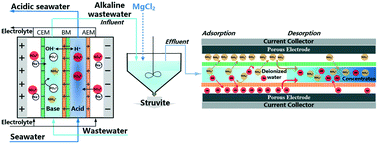当前位置:
X-MOL 学术
›
Environ. Sci.: Water Res. Technol.
›
论文详情
Our official English website, www.x-mol.net, welcomes your feedback! (Note: you will need to create a separate account there.)
Nutrient recovery from treated wastewater by a hybrid electrochemical sequence integrating bipolar membrane electrodialysis and membrane capacitive deionization
Environmental Science: Water Research & Technology ( IF 5 ) Pub Date : 2019/12/18 , DOI: 10.1039/c9ew00981g Fei Gao 1, 2, 3, 4, 5 , Li Wang 1, 2, 3, 4 , Jie Wang 5, 6, 7, 8 , Hongwei Zhang 5, 6, 7, 8 , Shihong Lin 1, 2, 3, 4, 9
Environmental Science: Water Research & Technology ( IF 5 ) Pub Date : 2019/12/18 , DOI: 10.1039/c9ew00981g Fei Gao 1, 2, 3, 4, 5 , Li Wang 1, 2, 3, 4 , Jie Wang 5, 6, 7, 8 , Hongwei Zhang 5, 6, 7, 8 , Shihong Lin 1, 2, 3, 4, 9
Affiliation

|
The growing needs for sustainable nutrient management and pollution control have motivated the development of novel technologies for nutrient recovery from wastewater. However, most of the existing technologies require extensive use of chemicals and intensive consumption of energy to achieve substantial recovery of nutrients. Herein, we present a hybrid electrochemical sequence integrating two relatively novel electrochemical processes, bipolar membrane electrodialysis (BMED) and membrane capacitive deionization (MCDI), for simultaneous removal of phosphorus and nitrogen. Specifically, the BMED process is employed to alkalify the wastewater to facilitate struvite precipitation and the MCDI process is used to further reduce the ammonia concentration in the effluent and concentrate the excess ammonia to a small stream. The electrochemical sequence is demonstrated to remove ∼89% of phosphorus and ∼77% of ammonia, recovering ∼81% of wastewater as a high-quality effluent that can be discharged or reused. This electrochemical treatment train minimizes chemical use and has competitive energy consumption as compared to electrochemical processes for nutrient recovery from wastewater.
中文翻译:

通过结合双极膜电渗析和膜电容去离子的混合电化学序列从处理后的废水中回收营养物
对可持续养分管理和污染控制的需求不断增长,推动了从废水中回收养分的新技术的发展。但是,大多数现有技术都需要大量使用化学物质和大量消耗能量,以实现养分的大量回收。在这里,我们提出了一种混合电化学序列,将两个相对新颖的电化学过程,即双极膜电渗析(BMED)和膜电容去离子(MCDI)结合在一起,用于同时去除磷和氮。具体而言,BMED工艺用于碱化废水以促进鸟粪石沉淀,而MCDI工艺用于进一步降低废水中的氨浓度并将多余的氨浓缩成小物流。经证明,电化学过程可除去约89%的磷和约77%的氨,回收约81%的废水作为可排放或再利用的高质量废水。与用于从废水中回收营养物的电化学过程相比,该电化学处理过程可最大程度地减少化学物质的使用并具有竞争性的能源消耗。
更新日期:2020-02-13
中文翻译:

通过结合双极膜电渗析和膜电容去离子的混合电化学序列从处理后的废水中回收营养物
对可持续养分管理和污染控制的需求不断增长,推动了从废水中回收养分的新技术的发展。但是,大多数现有技术都需要大量使用化学物质和大量消耗能量,以实现养分的大量回收。在这里,我们提出了一种混合电化学序列,将两个相对新颖的电化学过程,即双极膜电渗析(BMED)和膜电容去离子(MCDI)结合在一起,用于同时去除磷和氮。具体而言,BMED工艺用于碱化废水以促进鸟粪石沉淀,而MCDI工艺用于进一步降低废水中的氨浓度并将多余的氨浓缩成小物流。经证明,电化学过程可除去约89%的磷和约77%的氨,回收约81%的废水作为可排放或再利用的高质量废水。与用于从废水中回收营养物的电化学过程相比,该电化学处理过程可最大程度地减少化学物质的使用并具有竞争性的能源消耗。



























 京公网安备 11010802027423号
京公网安备 11010802027423号